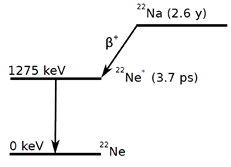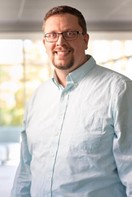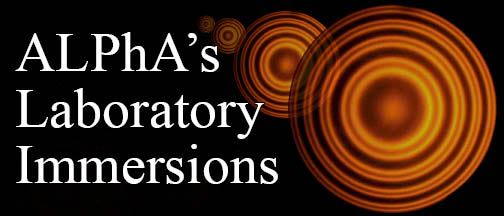- Home
- What We Do
- Laboratory Immersions
- Immersions 2023
- Imm2023StOlaf_PositronSpectroscopy
St. Olaf College, Northfield, MN
Positron Spectroscopy
Dates: July 27, 2023 to July 29, 2023
Number of setups available: 2
Maximum number of participants: 6
------------------------------------------------------------------------------------------------------------------------------------------
With its discovery in 1932 by Carl Anderson, the positron began the era of antimatter in physics. Unlike its antimatter counterparts, the antiproton and antineutron, the positron can be produced from radioactive sources. As such positrons are available for a large array of applications. PET scans, materials science, QED tests, fundamental symmetry experiments, and antihydrogen spectroscopy are some of the many areas in which positrons have found applications both historically and in the modern day. With this experiment we have a single apparatus along with data acquisition software that allows students to explore the variety of physics accessible with positrons. Currently the apparatus has been configured for students to explore γ-ray spectroscopy, PET scanning, low noise Compton scattering, speed of light, polarimetry of annihilation radiation, 3-γ spectroscopy, and positron lifetime spectroscopy. Apparatus arrangement for 3-γ spectroscopy is shown.

Figure 1 - 3-γ spectroscopy apparatus with 4 NaI detectors looking for coincidence signals γ-ray signals that mark this unusual decay route for Positronium atoms.
The existence of commercially available radioactive sources that produce positrons is key to making these experiments accessible to the undergraduate laboratory. The most common choice of source is 22Na with a decay scheme shown. In addition to providing positrons, the decay also produces a 1275 keV γ-ray shortly after the emission of the positron. This γ-ray along with the annihilation γ-rays produced when the emitted positrons interact with the environment form the backbone of these experiments.

Figure 2- The decay scheme of Na-22 that is used to produce positrons.
The foundation of the experimental apparatus is four 51 mm by 51 mm cylindrical NaI scintillation crystals paired with photomultipliers. NaI-based detectors are used to give the best balance of energy resolution, timing resolution, detection efficiency and affordability for γ-ray detection. The NaI detectors can be reconfigured into a variety of orientations for different experiments. To reduce costs and substitute for the traditional pulse processing electronics, we use a 4-channel USB-based oscilloscope. This oscilloscope allows the computer to capture the raw pulse data for each detection event and process it in software for energy and timing information.
Participants in this immersion will explore this apparatus and its setup. They will set up data acquisition for each of the experiments as well as explore the data analysis for these event-based experiments.
Cost of implementation:
4-NaI Detectors $6,000
USB Oscilloscope and Cables $4,000
22Na Sources $500
Lead Collimator $200
HV Power Supply $1,000
Miscellaneous Hardware and 3D Printing $200
 Jason Engbrecht completed a B.S. in physics at Trinity University, and an M.S. and Ph.D. in Physics at the University of Michigan, Ann Arbor. At Michigan he studied atomic physics, focused on positron physics.
Jason Engbrecht completed a B.S. in physics at Trinity University, and an M.S. and Ph.D. in Physics at the University of Michigan, Ann Arbor. At Michigan he studied atomic physics, focused on positron physics.
In recent years, Jason has played a founding role in the development of the new engineering concentration at St. Olaf. He has been a strong advocate and practitioner for student opportunities to pursue research experiences and has mentored 50 students in his laboratory working on antimatter and robotics research, including two Goldwater Scholars.
Growing out of his work in engineering education, Jason coached St. Olaf engineering teams in the national Rube Goldberg collegiate competition for four years. Twice these teams brought home the National Championship. He has been called upon to consult on the construction of entertaining Rube Goldberg machines on many occasions. Working with former St. Olaf students, he has led projects such as building displays for 3M and Target corporations and appearing on national television in the US and Japan with his displays.
Jason lives in Faribault, Minnesota with his wife, two daughters, and two dogs. He enjoys serving his community, serves on the church council of his home congregation, and coached the 2020 State Champion Faribault High School Robotics team.
Jason Engbrecht was appointed as the Associate Provost of St. Olaf College in June of 2022, working with the Provost of St. Olaf College to oversee the college’s academic programs and support the work of its faculty and academic staff.

Eric Hazlett Received his BS in Physics from Colorado State University where he was a McNair scholar. He received his PhD in physics from The Pennsylvania State University where his research interest focused on atomic physics, specifically laser cooling and trapping of fermions.
Eric has been at St. Olaf 4 years with previous experiences in industry and at Carleton College. At St. Olaf he has been teaching physics and engineering courses. His research interest lies in leveraging 3D printing and additive manufacturing to make physics more accessible. The creation of a 3D printed external cavity diode laser is a quintessential example of this effort. Outreach is another passion of his. He has incorporated service and outreach in his course work and serves as the community engagement lead for the physics department. Eric also serves as the Posse mentor for St. Olaf's virtual Posse cohort. Eric lives in Northfield with his wife and two kids and garden.Dr. Jason Engbrecht or Dr. Eric Hazlett, Email: engbrecht@stolaf.edu or hazlett@stolaf.edu.





